Platoon Blu-ray Movie
HomePlatoon Blu-ray Movie 
4K RemasteredShout Factory | 1986 | 120 min | Rated R | Sep 18, 2018
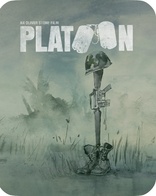
Movie rating
8.1 | / 10 |
Blu-ray rating
| Users | 2.2 | |
| Reviewer | 5.0 | |
| Overall | 2.9 |
Overview
Platoon (1986)
A young soldier must choose between his two platoon leaders and confront the horrors of war and the duality of man.
Starring: Tom Berenger, Willem Dafoe, Charlie Sheen, Forest Whitaker, Francesco QuinnDirector: Oliver Stone
| Drama | Uncertain |
| War | Uncertain |
| Melodrama | Uncertain |
| Action | Uncertain |
Specifications
Video
Video codec: MPEG-4 AVC
Video resolution: 1080p
Aspect ratio: 1.85:1
Original aspect ratio: 1.85:1
Audio
English: DTS-HD Master Audio 2.0 (48kHz, 24-bit)
English: DTS-HD Master Audio 5.1 (48kHz, 24-bit)
Subtitles
English SDH
Discs
Blu-ray Disc
Single disc (1 BD)
Playback
Region A (locked)
Review
Rating summary
| Movie | 5.0 | |
| Video | 5.0 | |
| Audio | 4.5 | |
| Extras | 3.0 | |
| Overall | 5.0 |
Platoon Blu-ray Movie Review
Stone's Oscar-Winning War Classic Receives Refurbished Transfer
Reviewed by Dr. Stephen Larson October 17, 2018Platoon and the films of Oliver Stone have had a profound impact on how I've viewed history. I'll never forget the seventh grade when our class' American history teacher (whom we affectionately called "Ma") showed us the VHS of Platoon. I remember quite vividly the night ambush scene and the ensuing battle with the North Vietnamese. We had a Vietnam veteran speak to our class and he lauded Platoon's authenticity. He also recalled the PTSD he experienced after returning from the war. One day he thought a VC/NVA helicopter had landed on the front lawn of his home (he called it the LZ) so he quickly ducked underneath his dining room table for cover. Our class had to write a term paper on a major war and I chose the Vietnamese Conflict. While I only got an average grade on the essay, it inspired my future scholastic endeavors. Stone's historical docudramas have compelled me to read the literary works that they're based upon and conduct further research on each subject's subtopics. As an undergraduate student, I began an intensive study of all of Stone's films (starting, ironically, on 9/11; I couldn't have predicted that he'd direct World Trade Center five years later!). Eventually, this became a senior thesis project on Salvador and Platoon. I spent many months poring over the critical literature on both films. I examined how Stone employed voice-over narration, angles of framing, music scoring, narrative construction, and sociopolitical commentary. I argued that these techniques emanated from classic documentaries and used Alain Resnais's early docs as a corollary. (Stone was very influenced by La Nouvelle Vague.) Around this period, I began a chain of correspondence with Sean Stone (Oliver's oldest son, whose now also a filmmaker), a fellow undergraduate at the time. Sean assisted me with the project and directed me to several resources and materials pertaining to his father's life and career.
One of my most valuable discoveries is how Platoon's first-person narration assumes the form of a self-objectification or double-focus. Applying the work of narrative theorist Sarah Kozloff, I learned how Platoon produces a category of character-narration as Chris Taylor (Stone's alter-ego played by Charlie Sheen) is the mouthpiece of the image-maker for the entire movie and the duration of his embedded story. The story is thus tightly attached to Taylor. The first five shots and final shot of an early scene in the film depict Taylor in a foxhole working up a sweat. Stone uses "homodiegetic narration" here, meaning that it comes from a character within the story. The twelve shots in between, however, incorporate "heterodiegetic narration" because the camera cuts away from Taylor to various members of the platoon while Taylor’s voice is heard over the images. Taylor’s experiential recitations provide reflection and introspection and they give the audience a breather from the fierce battle scenes.
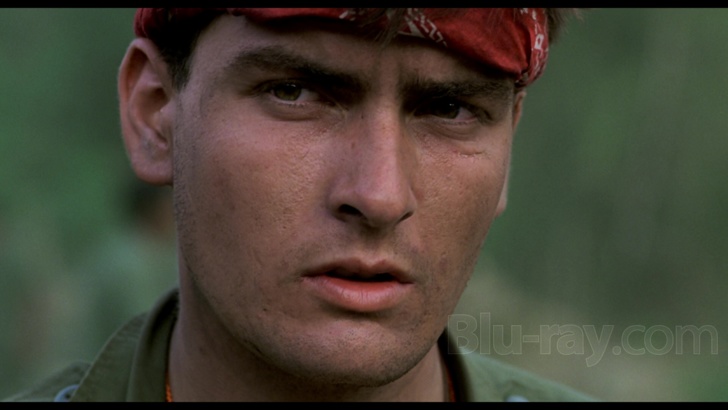
Chris wonders what he's gotten himself into.
Another important finding I made was that a large percentage of George Delerue's original score was rejected in favor of Samuel Barber's Adagio for Strings. I spoke to Sean about where at least three of Delerue's pieces were originally supposed to go in the film and synched up Prometheus Records' 1995 CD score album with a DVD of Platoon to compare what they sounded like compared to the Adagio. Barber and Delerue’s pieces can be differentiated in terms of their structure. Through many listens, perusing the sheet music, and critiques by Barber scholars, I learned that the Adagio consists of two movements following the standard principles of sonata form. This means that an Allegro in B minor is succeeded by B-flat minor. Throughout Platoon, only a few measures are integrated into the sound track and the Adagio repeats itself through constantly shifting harmonies. This type of musical performance is homophonic: different voices moving together in the piece rather than generating individual rhythmic independence. Delerue’s FINALE is the antithesis because it is heterophonic. In other words, different versions of the same melodic line are going on at once. This is one of several examples how Barber and Delerue's instrumental styles diverge. I'm developing this written work into a future article and monograph.
Why was two-thirds of Delerue’s score deleted? (I learned later from Spanish label Quartet Records' 2018 expanded Platoon soundtrack that more material went unused.) Stone wrote this reviewer in a March 2003 email that Delerue’s “actual simulation of Barber’s ‘Adagio for Strings’ wasn’t up to his usual standard.” We disagreed as I still believe that at least three of Delerue's cues should have been left in the film. After I finished my thesis, I gave it to Sean who took it with him to Morocco where his dad was filming Alexander. Oliver read it and wrote me a letter, thanking me for my appreciation of Delerue's music.
If there's one other flaw to an otherwise impeccable war film, it's the aforementioned scene where Taylor has to stay awake because Junior (Reggie Johnson) has dozed off during his mandatory nightwatch. Following several casualties and injuries, Sgt. Barnes (Tom Berenger) admonishes Taylor for his supposed negligence. Platoon is about the two surrogate fathers that come to define Taylor's time in Vietnam and who mold him into an experienced combat soldier. In the beginning, Taylor fears Barnes but later stands up and confronts him. By contrast, Taylor trusts and looks up to Sgt. Elias (Willem Dafoe). Why doesn't Taylor tell Elias about Junior's malefaction so he's reprimanded instead? Later in the film, Captain Harris (Dale Dye) meets with Barnes and Elias about an atrocious incident, threatening a court-martial if misconduct is found. The subplot with Junior is a hole in an otherwise wonderful shooting script by Stone, who received his third Oscar nomination for writing.
Platoon Blu-ray Movie, Video Quality 
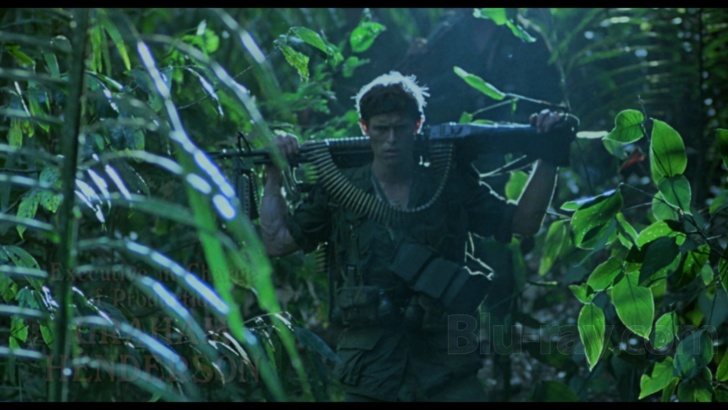
Platoon has had a checkered history on home video to say the least. HBO Video and Vestron Video/Image Entertainment issued 1.33:1 presentations on LaserDisc in March 1988 and January 1989. Charles Kiselyak, a making-of video documentarian came to the rescue in 1995 when he enlisted the participation of both Oliver Stone and cinematographer Robert Richardson for a THX-certified Pioneer Special Edition LD box set, which I own. Platoon had a budget of $6.5 million and was made independently through Hemdale Film. In '86, Richardson didn't have sufficient funds to mix in more black and white during post production. So when he did the film-to-tape transfer with Kiselyak (using a "mint 35mm interpositive"), then-new computer software afforded him that option. Kiselyak writes in the inside of the LD release's hardbound scrapbook that "greens have more black in them and the fleshtones capture the subjective reality at war in each character...the flames are truly hot, the deep interior of the jungle is almost blue with indifference, and the amber interiors evoke subterranean forces. This transfer...captures the originally intended look for the first time." While Stone didn't officially co-supervise the color retiming, he had some input. In a Pioneer-exclusive video intro, Stone notes that the sharper contrasts and stronger colors improve upon how the film was shot. "The blacks are really black and the whites are really white. There's almost an impressionable color that haunts through the film." Two years later, LIVE Entertainment (which also carries the THX stamp) reissued the same transfer on a progressively-encoded DVD9. While the back cover of the snapper case states "Director Approved Transfer," it's really the Richardson transfer. Screenshot #s 18, 20, 22, 24, and 26 are struck from LIVE. When MGM acquired the rights to Platoon a few years later, it not only dropped all of the special features but also used a different print. I compared shots of the opening scene from the LIVE with the MGM and the latter has noticeably more film artifacts, stemming presumably from a recycled theatrical print.
Flashforward to 2018 and Shout! Factory has brought Stone in for final approval of a brand-new 4K restoration. This is a SteelBook with a grey/olive/light blue cover image that looks similar to the front cover on the original hardback of James Jones's novel, The Thin Red Line (the drawing of the army helmet over the butt of the rifle). I was impressed with the transfer that MGM did circa 2011 but this new scan is a step up. Platoon appears in its original theatrical aspect ratio of 1.85:1 on this MPEG-4 AVC-encoded BD-50. The Pioneer LD/LIVE DVD displays a little more information as it's framed in approx. 1.93:1. On the Shout, check out the detail on Taylor's face (#1) and the several scars on Barnes (#12). Grain makes its presence known in shots of the sky (see around the lightning bolt in #13). Black levels are whole and deep (without oozing any crush).
In comparing the Shout! and LIVE transfers, you'll immediately notice the discrepancies in color and light. The shot of Chris coming off the C-130 (#18) has an off-white, washed-out look, indicating that Richardson de-saturated the hues. It also boasts some mosquito noise and looks more like video than film. The Shout! has warmer skin tones. Which transfer more accurately reflects the original release prints? I'd lean towards the Shout! Malcolm L. Johnson, film critic for the Hartford Courant pointed out in his 1987 review the airstrip not only appears "dusty" but also "sunny" as well. Richardson tweaked the image so the jungle has more of a dark blue-green tinge (see # 24). There's a purple haze in the air in #20 compared with the grey/light blue in #21. Contrast is vastly different between the two. Look at how dark it is in #26 contrasted with the light on Taylor and Bunny (Kevin Dillon) in #27. The sky looks almost salmon/pinkish in 26. Shout! and Stone have done a lighter green that blends in with the Army soldiers' camouflaged fatigues. This seems to replicate the palette on the theatrical. The Daily Oklahoman's film critic Tony Frazier described, in January '87, the Philippine jungles as "lush." The LIVE is considerably more darker too. The Shout! image is extremely clean (while retaining grain) with only some tiny white specks noticeable in one of the battle scenes.
Compared to MGM's 25th Anniversary Blu-ray, Shout! is a notch brighter. Authoring and compression are superior on the Shout! MGM's disc size is 41.54 GB, Shout!'s 48.48 GB. MGM has encoded the transfer at a mean bitrate of 26708 kbps; Shout! 31999 kbps.
Shout! has given the two-hour movie twelve selections. (LIVE has thirty-five chapter stops!)
Platoon Blu-ray Movie, Audio Quality 
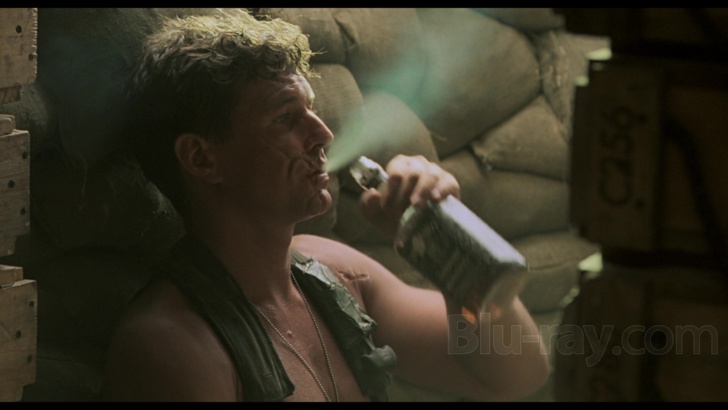
Shout! has supplied a remixed DTS-HD Master Audio 5.1 Surround (2571 kbps, 24-bit) and encoded the original Dolby Stereo as a DTS-HD Master Audio 2.0 (1706 kbps, 24-bit). The latter is the first time the original 2.0 has been on a digital disc since 1997. What elements did Shout! have to work with? Platoon originally had a six-track mix, which in the theaters back in 86-87, probably was left-right front-rear with two boom tracks. When Kiselyak remastered the Dolby Stereo tracks on an advanced mixing board, he produced as much surround effect as possible, while carefully preserving the vocal centerstage. When I first listened to the DTS 5.1 on Sony Pictures' 20th Anniversary Edition DVD, I heard only occasional f/x on the surround channels. Spoken dialogue on the Shout! is clean, clear, and crisp. F/x on most of the battle scenes have a "hi-fi stereo" sound typical of low-budget eighties films. The final firefight sounds utterly spectacular with the satellite speakers given their most activity than at any other moment in the film. "Tracks of My Tears," "White Rabbit," and "Okie Muskogee" show very good depth and range along the fronts. The Barber Adagio and selections of Delerue's score that were used are well-balanced. I prefer the Shout! lossless 5.1 over MGM's 2011 English 5.1 track (2024 kbps), which is done at a depth of 16-bit.
Optional English SDH for the feature are available on the main menu or via remote activation.
Platoon Blu-ray Movie, Special Features and Extras 

For the Pioneer LD package, Kiselyak and Stone put together a 120+ page scrapbook that is profusely illustrated with photographs from Stone's tour of duty in Vietnam and on-set snapshots of cast and crew at work in the Philippines. It also includes a comprehensive screenplay delineating every scene and line that Stone considered in his various drafts of Platoon complete with his annotations. Hopefully, a book publisher will someday reissue the scrapbook. One of the LDs also sports over 200 production photos, including many not in the book. The LD SE, LIVE DVD, MGM SE, and Sony SE include the outstanding Tour of the Inferno documentary on the making of Platoon.
None of the above bells and whistles are ported over on the Shout! package. Why is Tour of the Inferno still absent on Blu-ray? Likely because Sony still has the rights and it was expensive for MGM to buy them back and for Shout! to pay their own licensing fees. Also missing are an eight-page collector's booklet and a photo/still gallery of thirty-one images that were on some of the DVDs.
Shout! has retained the bonus material from the first MGM/Fox Blu-ray release. However, unlike the prior BD, these do not include any subtitling options. MGM/Fox even provides subs for the commentaries.
Let me say that we are extremely fortunate to have any surviving deleted scenes. My senior project advisor, a professional screenwriter whose worked with Coppola, suggested that I see if there are any extant reels in Stone's garage. In the early 2000s, there weren't any excised scenes on any of the DVDs. When I made my inquiry to Stone, he wrote back: "There were very few deleted scenes from 'Platoon'. We shot pretty much what we used. There was a ghost scene, but it wasn't done very well. The schedule and budget were very minimal, so we basically made it work." A couple years later, Stone would find these recycled reels in his storage. These are definitely golden scraps. Nearly every scene (including an alternate ending) Stone wishes that he would have left in the final cut.
- Audio Commentary by Writer/Director Oliver Stone
- Audio Commentary by Military Advisor Captain Dale Dye
- Nine Deleted and Extended Scenes (with Optional Audio Commentary by Oliver Stone) (11:32, upscaled to 1080i)
- Flashback to Platoon: "Snapshot in Time: 1967–1968" (19:15, upscaled to 1080i)
- Flashback to Platoon: "Creating the 'Nam" (12:04, upscaled to 1080i)
- Flashback to Platoon: "Raw Wounds: The Legacy of Platoon" (17:19, upscaled to 1080i)
- Mini-Doc: "One War, Many Stories" (25:33, upscaled to 1080i)
- Mini-Doc: "Preparing for 'Nam" (6:37, upscaled to 1080i)
- Featurette: "Caputo & the 7th Fleet" (1:39, upscaled to 1080i)
- Featurette: "Dye Training Method" (3:23, upscaled to 1080i)
- Featurette: "Gordon Gekko" (1:07, upscaled to 1080i)
- Theatrical Trailer (1:37, 1080p)
- Three TV Spots (1:34, upscaled to 1080i)
Platoon Blu-ray Movie, Overall Score and Recommendation 
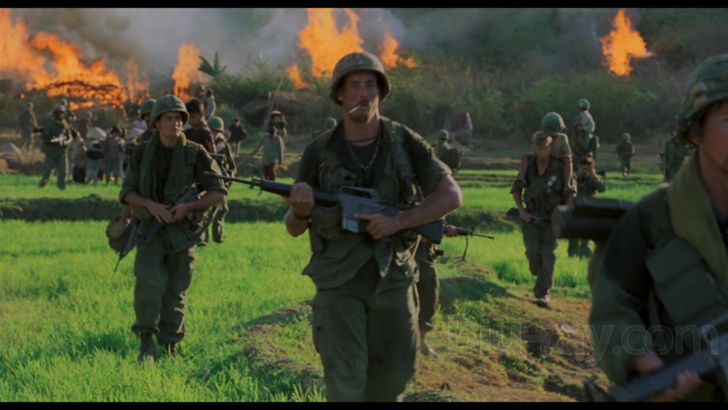
Each actor who appeared in Platoon can claim proudly that his performance contains some of the best work in each one's respective career. Platoon remains a model for its representation of the grunt's eye view of war and "the six inches in front of my face," as Stone remembers it. While this Shout! Factory SB is missing various supplements from previous releases, it sports a nearly perfect transfer that closely replicates the film's original theatrical appearance. It's also an added bonus to have the original 2.0 stereo on an uncompressed track. MY HIGHEST RECOMMENDATION.
Other editions
Platoon: Other Editions

Platoon 4K
1986

Platoon 4K
Collector's Edition
1986

Platoon
Limited Edition Collectible Cover Art | Single Disc
1986

Platoon
1986

Platoon
Awards O-Ring Slipcover
1986

Platoon
Limited Edition Collectible Cover Art | Single Disc
1986

Platoon
VUDU Digital Copy + VUDU Offer
1986

Platoon
Comic Con Exclusive
1986

Platoon
1986

Platoon
MGM 90th Anniversary
1986

Platoon
25th Anniversary Edition
1986

Platoon
1986
Similar titles
Similar titles you might also like

Apocalypse Now 4K
Final Cut | 40th Anniversary Edition
1979

The Thin Red Line
1998

The Deer Hunter 4K
Collector's Edition
1978

The Green Berets
1968

Full Metal Jacket 4K
Rerelease
1987

Hamburger Hill
1987

Cross of Iron
1977

Generation Kill
2008

The Dirty Dozen
1967

We Were Soldiers 4K
2002

Jarhead
2005

Saving Private Ryan 4K
Commemorative 20th Anniversary Edition
1998

Stalingrad
1993

Wings
1927

5 Days of War
2011

The Longest Day
1962

9th Company
9 rota | Collector's Edition
2005

A Bridge Too Far
1977

The Blue Max
Limited Edition to 3000 - SOLD OUT
1966

Merrill's Marauders
Warner Archive Collection
1962